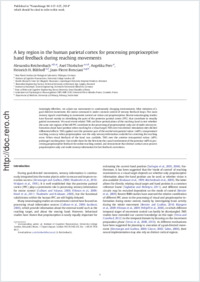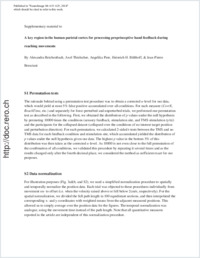A key region in the human parietal cortex for processing proprioceptive hand feedback during reaching movements
- Reichenbach, Alexandra Max Planck Institute for Biological Cybernetics, Tübingen, Germany - Institute of Cognitive Neuroscience, University College London, UK
- Thielscher, Axel Max Planck Institute for Biological Cybernetics, Tübingen, Germany - Danish Research Center for Magnetic Resonance, Copenhagen University Hospital, Hvidovre, Denmark - Biomedical Engineering Section, Technical University of Denmark, Kgs. Lyngby, Denmark
- Peer, Angelika Institute of Automatic Control Engineering, Technische Universität München, Germany
- Bülthoff, Heinrich H. Max Planck Institute for Biological Cybernetics, Tübingen, Germany - Dept. of Brain and Cognitive Engineering, Korea University, Seoul, Korea
- Bresciani, Jean-Pierre Max Planck Institute for Biological Cybernetics, Tübingen, Germany - Laboratoire de Psychologie et Neurocognition, Université Pierre Mendès-France, Grenoble, France - Department of Medicine, University of Fribourg, Switzerland
-
01.01.2014
Published in:
- NeuroImage. - 2014, vol. 84, p. 615–625
Motor control
On line control
Posterior parietal cortex
Proprioception
Reaching
Transcranial magnetic stimulation
English
Seemingly effortless, we adjust our movements to continuously changing environments. After initiation of a goal-directed movement, the motor command is under constant control of sensory feedback loops. The main sensory signals contributing to movement control are vision and proprioception. Recent neuroimaging studies have focused mainly on identifying the parts of the posterior parietal cortex (PPC) that contribute to visually guided movements. We used event-related TMS and force perturbations of the reaching hand to test whether the same sub-regions of the left PPC contribute to the processing of proprioceptive-only and of multi-sensory information about hand position when reaching for a visual target. TMS over two distinct stimulation sites elicited differential effects: TMS applied over the posterior part of the medial intraparietal sulcus (mIPS) compromised reaching accuracy when proprioception was the only sensory information available for correcting the reaching error. When visual feedback of the hand was available, TMS over the anterior intraparietal sulcus (aIPS) prolonged reaching time. Our results show for the first time the causal involvement of the posterior mIPS in processing proprioceptive feedback for online reaching control, and demonstrate that distinct cortical areas process proprioceptive-only and multi-sensory information for fast feedback corrections.
- Faculty
- Faculté des sciences et de médecine
- Department
- Département de Médecine
- Language
-
- English
- Classification
- Biological sciences
- License
-
License undefined
- Identifiers
-
- RERO DOC 210100
- DOI 10.1016/j.neuroimage.2013.09.024
- Persistent URL
- https://folia.unifr.ch/unifr/documents/303672
Other files
Statistics
Document views: 114
File downloads:
- pdf: 284
- Supplementary material: 123

